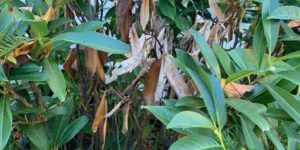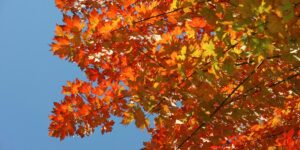Some winters in New Jersey are dry, most are snow-filled, and occasionally we’ll get freezing rain or even an ice storm that leaves you with ice-covered trees, downed power lines and flattened shrubs. Knowing what to do (and what not to do!) when your trees are covered in ice can make the difference between healthy or dying trees in spring.
Why ice-covered trees are dangerous
In many ways, ice can be the most dangerous of all the winter hazards (and not just because it makes driving treacherous!).
When ice coats tree branches, the added weight can cause branches to break and fall, damaging anything (or anyone) in their path. Multi-stemmed trees, those with narrow branch crotches (like Bradford pears), and evergreen shrubs (such as arborvitae) also get weighed down with ice and start to split or splay outward.
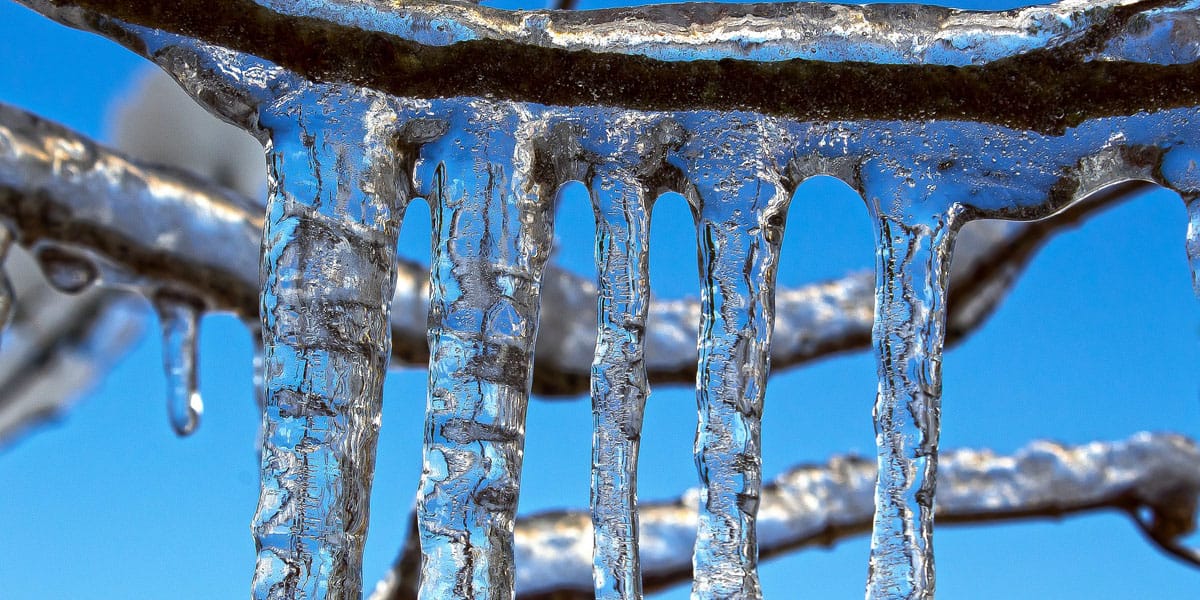
Ice can weigh down tree branches, causing them to break and fall
Other things also make an ice-covered tree to be dangerous, so before approaching one, check for these things:
- Is the ice-covered tree touching or in close proximity to power lines? If so, contact your utility company before going near it. In some situations, you can be electrocuted even without touching the tree.
- Are any branches broken or hanging from the tree? Take a careful look, as you can’t always tell if an ice-covered branch has already broken or is just bent under the weight of the ice. Sometimes a bent branch will recover as the ice melts, but sometimes it will snap unexpectedly. Try not to walk beneath any broken branches as they can fall without notice.
- Is any part of the tree blocking a roadway, walkway, or driveway? Don’t try to cut the tree yourself with a chainsaw – the ice makes any use of power tools extremely dangerous because of the slick surface. Any ice that comes in contact with power tools can become a projectile and cause injury as well. With all the ways that you can hurt yourself, it’s much wiser to call in a professional to remove the tree or branches.
PRO TIP: Ice damage isn’t the only problem your trees will face during the winter. Learn more about evergreen winter burn and how to prevent it in your trees with our guide.
What you can do right away
Once you’ve assessed the danger and determined that there’s no safety risk, there are a few things you can safely do for ice-covered trees.
Overall, the best thing is to wait until the ice has melted. We know it’s tempting to get outside and try to “help” your trees. But, for the most part, they’ll be just fine without any assistance.
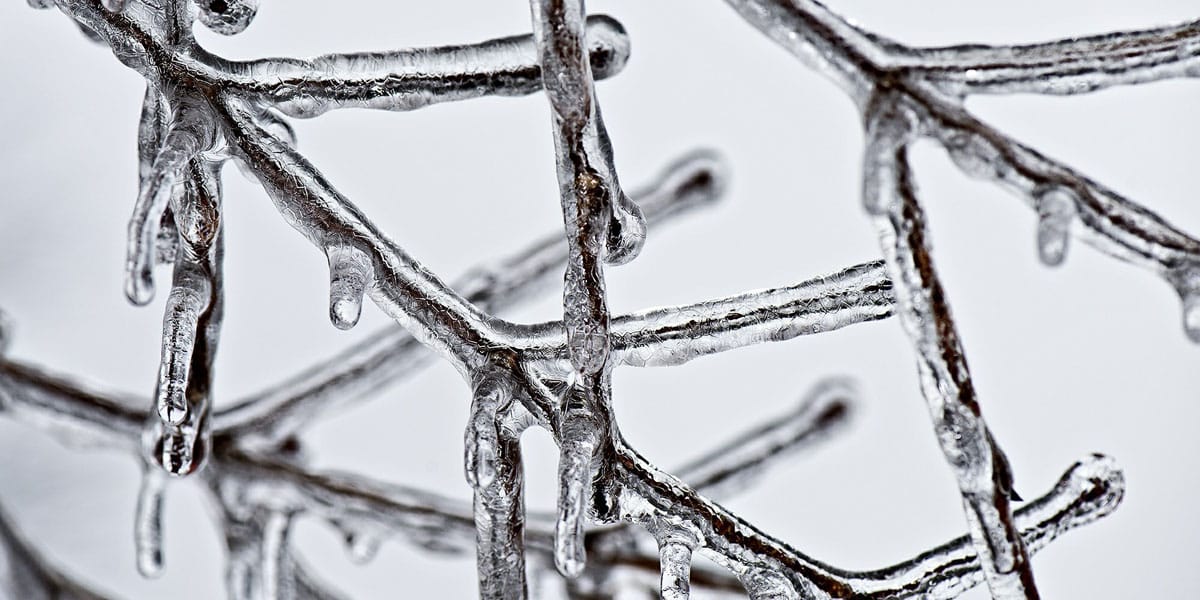
Wait for the ice to melt on trees and shrubs
For smaller trees and shrubs, you can (carefully!) prune out broken branches and pick up any fallen debris. Just don’t walk under any ice-covered trees or structures unless you have some sort of protection on your head (like a hard hat), as ice can break off and fall at any time.
What you should not do
You may think that removing the ice will help your tree or shrub, but that’s not necessarily the case. Don’t shake the tree or shrub or hit it with anything (like a broom or a rake). This only damages the tree and causes ice, snow, and/or branches to break and fall.
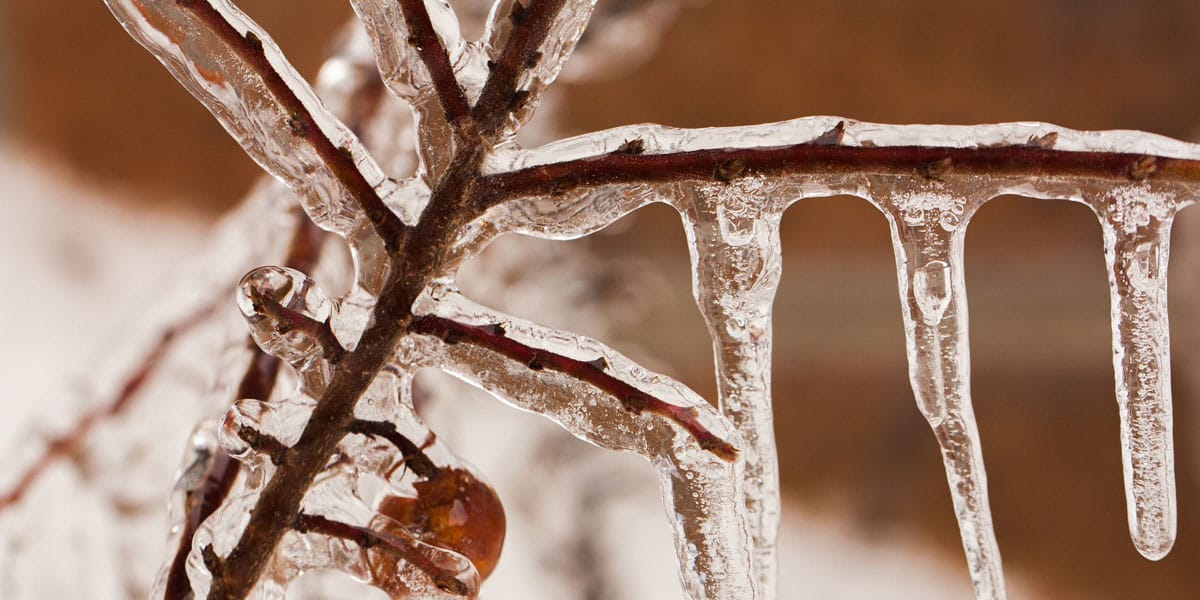
Waiting is your best option in most cases
Don’t spray the trees or shrubs with water in an attempt to melt the ice – the added water will eventually turn to ice as well, making the problem worse.
Finally, refrain from using any kind of ice melt or salt on or around any plants – this is a sure way to kill them. (You may have noticed that some of your plants or trees near roads or walkways that have been treated with ice melt products often turn brown or die – that’s the effect of salt damage).
What you can wait to do
As mentioned earlier, sometimes the best thing to do is wait for the ice to melt. Most trees and shrubs will recover from the stress caused by the ice and should function normally by spring. However, if spring arrives and you notice that they have not recovered, it may be time to request a consultation with a professional arborist.
Sometimes professional corrective pruning may be needed if the bark has been torn or if a fallen branch left behind a jagged stub. Contact us for the best time to have this done (usually, correcting pruning is done before spring bud break).
If so much of the tree is damaged that pruning more than 50% of it is necessary, it may be better to remove the tree. Extensive pruning, especially pruning that essentially “tops” the tree, restricts its ability to produce energy through photosynthesis (leaving it weaker and more susceptible to pests and disease) and leaves it disfigured.
For damaged shrubs, some kinds can be cut to the ground in spring (this is called rejuvenation pruning). However, this doesn’t work for all types so be sure to research what kind of shrub you have before attempting to do this. For shrubs with extensive damage that cannot tolerate rejuvenation pruning, you may want to consider a replacement.
Which trees/shrubs are most vulnerable to ice damage
While all plants can suffer from winter damage, some are more susceptible than others. Fast-growing trees tend to have softer wood, so trees like elms, birches, poplars, and willows can suffer from the extra weight that snow or ice brings.
Fruit trees need a little extra TLC as well.
Evergreen shrubs can be split after a heavy snow or ice storm, and some tend to lean over from the weight.

Evergreens can be damaged by ice
If an ice storm hits early in winter or late in fall, deciduous trees may still have their leaves. Ice-coated leaves are heavy and brittle, which causes extra strain and damage to the trees. If those trees survive, they will need a little extra care to recover.
What you can do BEFORE ice hits (again)
As with most things, prevention can go a long way when it comes to ice damage. Of course, you can’t prevent all damage caused by ice, but ensuring that your trees and shrubs are healthy and well-maintained can make a big difference.
Before winter arrives, have your trees professionally inspected and then address any issues that may be found. Specific things to look out for include:
- Trees that are multi-stemmed or that have more than one main stem (they’re prone to splitting apart under heavy snow or ice load)
- Broken or dead branches that are likely to fall off when ice-covered
- Split trunks
- Narrow branch crotches
Some of the above issues can be addressed with corrective pruning, others – like multi-stemmed trunks – need cabling to maintain the tree’s integrity.
To prevent ice damage to your shrubs (especially evergreens like arborvitae), wrap them in burlap or another protective fabric. Remove the fabric in spring, though, or the shrubs will die when temperatures rise. Learn more in our post on winter tree care tips.
If you have concerns about any of your trees, give the Certified Arborists at Alpine Tree a call. We’re happy to inspect your trees at any time and will let you know what, if anything, should be done to protect or repair them from ice damage.


